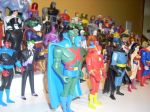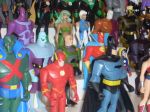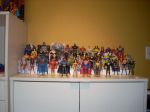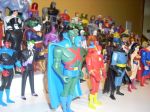You are currently browsing the tag archive for the ‘comic books’ tag.
Yesterday I received an email from my son’s teacher. It said something to the affect of:
“Thelonious asked a very good question during our Bible lesson yesterday that takes a higher level of questioning than I usually see in a 5th grader. He asked how we know God is real. And, how do we know the Bible is real and not just some thing the authors made up. These questions are a little beyond what the other 5th graders are asking, so I couldn’t get into it with him very much. I thought you might like to give it a go.”
Well, as a matter of fact, it just so happens that I do hold a masters degree in theology. So, I guess I’m actually fairly qualified to broach this topic.
As Thelonious and I lounged around last night, wasting a few minutes before bed, I laid down on his bed and we had a little conversation. “Your teacher says you’re asking annoying questions in Bible class. Stop it.” I kid. “I hear you’re having some pretty serious questions in Bible class. Want to talk about them?” See, sometimes, my kids bring up life altering issues at school but they don’t really care about the answers all that much. Questions of existence can simply be a passing fancy in the Fox household. But, he remembered the questions. How do we know God is real? And, how do we know the Bible just isn’t made up?
So, like any properly trained pastor, I asked him, “what makes you think that God isn’t real?” His answer was simple: if God is real, bad things wouldn’t happen. Great. 10 years old and I have to deal with issues of theodicy (the first of many vocab words he learned during this conversation). So, like any properly trained pastor, I asked probing questions that steered the conversation towards issues of choice. But, apparently, free will isn’t very important to Thelonious.” Why doesn’t God stop me from doing bad things?” “Why doesn’t God stop me from being mean to Ione?” Pretty soon the conversation degraded into “why don’t you stop me? why doesn’t mom stop me? why doesn’t the playground monitor stop me?” Apparently, there is only one person who is not responsible for Thelonious’ personal choices – and, that person is Thelonious.
Our conversation went on and on. It was pretty fun to get inside his head and mess it all up and see how he thinks. The dialogue was far reaching and bounced back and forth from one corner of his cynical little mind to the other corner of his agnostic little mind. Every time I looked over at him, his little face was all twisted up and distorted. It was (literally) a look of pain. A look of deep, deep thought. His brain was working so hard that it actually couldn’t send messages to his face telling it to keep it looking the way it is supposed to look. I won’t bore you with all the details, just the conclusion…
“Dude, let me tell you about the only philosopher that really matters: Søren Kierkegaard. Kierkegaard said that when it is all said and done, we just don’t know for sure. You can’t know for sure. And, nothing anyone says can make you know for sure. Kierkegaard called it “the leap of faith.” Sooner or later, you’re just gonna have to take a leap of faith.”
I may have been a little too esoteric (another vocab word he learned last night). I may have been a little too ambiguous and non-committal. I may have been lacking in anything that could actually be called an answer. I may have been way too comfortable in the grey world of “I dunno.” But one thing is for sure. I kissed him good night and said, “I love you.” And, for the first time in a year and a half, he replied with, “I love you.” See, he gave up that little kid gesture of verbally communicated affection long ago. But, apparently, a parent who will sit with you in the unknown (and introduce you to the depressed Dane) is irresistibly lovable.
As I got up from his bed and started to leave the room, Thelonious wanted to ask me one final question… After the conversation at school, the teacher asked the rest of class: “class, what do you think of these questions?” One little girl raised her hand and said that she knew the Bible was true because what it contained was so amazing and wonderful that it was beyond human ability to imagine or make up any of it. (Anselm… that line of reasoning is so 5th grade.) Thelonious continued: “but, ya know what? I think that doesn’t make any sense. I mean, the stories in the Bible really aren’t all that amazing.” Letting him read comic books was a very bad idea.
 Yes, I am talking to you, Justice League Unlimited figures. Big Barda, Deadshot, Star Sapphire, both Huntresses, Parasite, Solomon Grundy – I got allll the hard to find ones. And, when you pay $50 for a 3.5″ chunk of painted plastic, ya really want that thing to stand up so you can at least look at. Well, I’m not going to tell you how long I spent getting these things to stand up today. I made little stands out of white poster tacky goo stuff for the poorly balanced. It molds to the shape of their feet and then sticks (for a short while) to the surface. I had them all standing nice and straight, and then I went for the camera. As I turned it on, Dr. Light (the hero, not the insane villain that was just killed by the Spectre in Final Crisis) toppled over and knocked down Booster Gold, who knocked down Hawk, who spun around and tipped over Black Canary, etc, etc, etc.
Yes, I am talking to you, Justice League Unlimited figures. Big Barda, Deadshot, Star Sapphire, both Huntresses, Parasite, Solomon Grundy – I got allll the hard to find ones. And, when you pay $50 for a 3.5″ chunk of painted plastic, ya really want that thing to stand up so you can at least look at. Well, I’m not going to tell you how long I spent getting these things to stand up today. I made little stands out of white poster tacky goo stuff for the poorly balanced. It molds to the shape of their feet and then sticks (for a short while) to the surface. I had them all standing nice and straight, and then I went for the camera. As I turned it on, Dr. Light (the hero, not the insane villain that was just killed by the Spectre in Final Crisis) toppled over and knocked down Booster Gold, who knocked down Hawk, who spun around and tipped over Black Canary, etc, etc, etc.
Once they were all standing, I snapped a few photos so you could behold my action figure glory. Feel free to look – but, don’t touch!
And, no. I do not care if you think I am a geek.
 I admit it, I watch a lot of cartoons. And, before you start judging me – they are no less mature than reality tv, so there. The other night, I was trying to convince my kids to watch “Doomsday: the Death of Superman” (again) and they moaned and whined – “we just wanna watch regular cartoons.” OK, OK, lets see what’s on Tivo. Surprise, surprise, there were a couple of new episodes of “Chop Socky Chooks.” (does the period go before or after the closing quotation mark? I never get that right. In this case, common sense tells me that it should go after the quotation mark, unlike a sentence of dialogue where it would go before the quotation mark. But, grammar doesn’t make any sense, it’s just a bunch of rules my cruel 7th grade teacher, Miss Fulcomer, forced me to learn.)
I admit it, I watch a lot of cartoons. And, before you start judging me – they are no less mature than reality tv, so there. The other night, I was trying to convince my kids to watch “Doomsday: the Death of Superman” (again) and they moaned and whined – “we just wanna watch regular cartoons.” OK, OK, lets see what’s on Tivo. Surprise, surprise, there were a couple of new episodes of “Chop Socky Chooks.” (does the period go before or after the closing quotation mark? I never get that right. In this case, common sense tells me that it should go after the quotation mark, unlike a sentence of dialogue where it would go before the quotation mark. But, grammar doesn’t make any sense, it’s just a bunch of rules my cruel 7th grade teacher, Miss Fulcomer, forced me to learn.)
Chop Socky Chooks is one of the rare cartoons that everyone in the family truly enjoys. Why? What makes a “quality” cartoon?
- Opening Sequence/Theme Song
I won’t watch a show unless the theme song is worthy of being added to my iTunes (a la Teen Titans or Spiderman) or the opening sequence inspires me to acts of super heroic do-gooding and/or acrobatic feats of violence (a la Justice League or Avatar) - Animation Style
The Chooks have that sick computer generated style that makes them look like real live claymation (think Rankin & Bass classics). Jimmy Neutron the TV show tried to pull this off but kinda failed – but, props to them for including a robot dog with a visible brain! - Multiple Levels of Meaning (including the subversive)
Ya, I know “Super Friends: Challenge of the Super Friends” worked on one level and one level only but it still kicks ass! It’s Ione’s favorite. Anyways… and, here we get to the meat of this post:
The subversive messages in Chop Socky Chooks
FIRST, the bad guy owns a MALL! Dr. Wasabi’s evil empire is a shopping mall!!! Secondly, none of the heroes are white males. Thirdly, Chuckie Chan’s study and devotion to the martial art of “Kung Pao” compels him to fight for the oppressed and against injustice. And, finally, Karmagatchas!
In the last episode I watched, the evil Dr. Wasabi had created the had-to-have-Christmas-time-cute-furry-craze: the Karmagatchas. Sadly, Chuckie was reduced to taking a job as one of Santa’s elves selling the Karmagatchas because “being the sensei of the dojo is fully rewarding in all ways except monetarily” (ohhhh, the call to ministry). Turns out the Karmagatchas are evil little toys that suck out a persons good karma by hugging them. How’s that for a subversive anti-consumerist message?
Naturally, my kids missed this message because they were busy trying to work out a trade for Ione’s new Pokémon card which is so damn cute (and shiny!) that Thelonious is nearly willing to trade a level EX card just to get his grimy lil hands on it. I missed the message because I was obsessing over how to get my collection of Justice League Unlimited figures to actually stand up [see the future post: Damn You, Skinny Ankled Action Figures!!! (or, Why Unbalanced Action Figures Are From the Devil)]. And, poor Erika. She missed the message because she had passed out from a hard day’s work of making money so the other three of us could spend it on cute-furry-gotta-have-its.
PS: I realize that Chop Sooky Chooks has come under criticism for over-simplifying and stereotyping Asian culture. To any reader whom I have offended, I sincerely apologize
Last week I read Jesus the Liberator for my Christology class. The assignment was to read it and then create a poster about it – as opposed to writing a paper. What’s this? An assignment that actually caters to my strengths?!?!
 I juxtaposed an image of a Latin American style crucifix (meaning bloody) with some comic book art. In the early 70’s, Green Arrow joined up with Green Lantern in issue #76 for a long run as a duo. This was an amazing time in comic books. The work of Neal Adams and Dennis O’Neil was groundbreaking. It wrestled with the issues of social justice, the poor, systemic violence and prejudice. The creative team used the two Greens to explore both sides of the issues: Green Arrow was an outspoken and strident advocate of the underprivileged in society and the political left wing while Green Lantern was a cerebral, sedate model citizen who followed the rules as an establishment conservative figure, serving existing institutions of government and law.
I juxtaposed an image of a Latin American style crucifix (meaning bloody) with some comic book art. In the early 70’s, Green Arrow joined up with Green Lantern in issue #76 for a long run as a duo. This was an amazing time in comic books. The work of Neal Adams and Dennis O’Neil was groundbreaking. It wrestled with the issues of social justice, the poor, systemic violence and prejudice. The creative team used the two Greens to explore both sides of the issues: Green Arrow was an outspoken and strident advocate of the underprivileged in society and the political left wing while Green Lantern was a cerebral, sedate model citizen who followed the rules as an establishment conservative figure, serving existing institutions of government and law.
Using art from the first Green Lantern/Green Arrow story seemed appropriate – the two sides of one conflicted mind in constant tensions about the problem of the poor.
Get the picture?
Here are a series of quotes which helped me summarize the book…
Liberation and crucifixion provide the basic tension for Christian faith and also the basic objective tension in christology…By faith we know clearly that where there is a poor person there is Jesus Christ himself…The poor are a sort of sacrament of the presence of Christ… If the Kingdom of God is “good news,” its recipients will help fundamentally in clarifying its content…The Kingdom belongs uniquely to the poor… By the mere fact of being poor, whatever the moral or personal situation in which they find themselves, God defends them and loves them, and they are the first ones to whom Jesus’ mission is directed…The poor are those for whom life is a heavy burden on the basic level of survival and living with a minimum of dignity…The ultimate definition of God is not power, nor thought, nor judgement, but goodness… What underpins reality is not an absurdity but something positive, and this something positive is not an impersonal force, but something good and personal, a God whom he called Father…Doing the will of God is treating people with justice, not observing religious rules…Jesus’ practice and teaching demand absolutely the unmasking of and a resolute struggle against structural injustice in the form of institutionalized violence.
No wonder liberation theology never caught on in the States…






